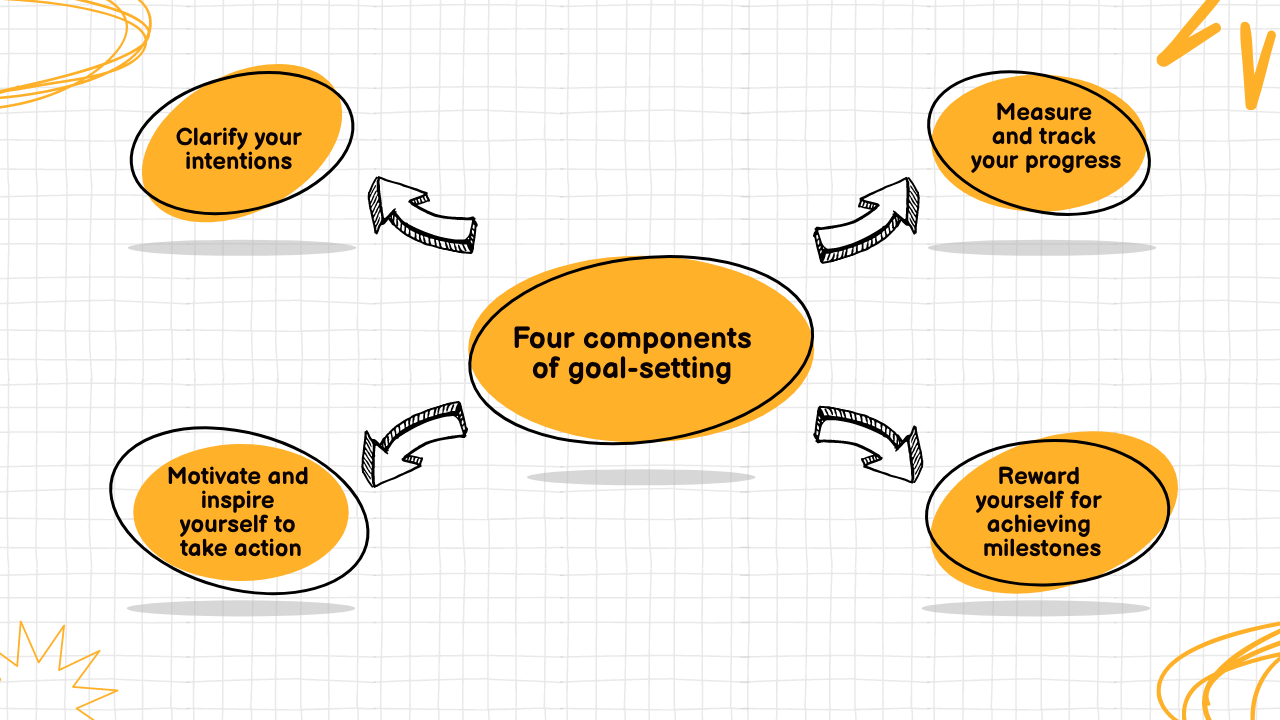How to Overcome Roadblocks When Reaching for Work Goals
What are roadblocks that keep us from reaching our work goals? Do you know what they are? We all have them, and sometimes we even create them ourselves. Learn how to overcome them.

So, you're ready to reach for that next rung on the ladder. When you set your professional goals, you direct them at:
- Clarifying your intentions
- Motivating and inspiring yourself to take action
- Measuring and tracking your progress
- Celebrating and rewarding yourself for achieving milestones

With this in mind, you know what you want as your work goals, and you've got a plan for how to get there. But sometimes it can feel like there's an invisible wall in your way.
What are roadblocks
The Challenge: Having objectives at work involves combining the various aspects of one's life.
Why? Because the spectrum of goal setting is pretty wide and ranges from completing daily to-do lists to reaching annual or longer-term goals.
You may delay, but time will not. – Benjamin Franklin

When reaching goals in your career, you may encounter roadblocks. It's important to understand that these obstacles are often a natural part of the process.
Factors to consider in goal setting:
- applying known skills and practicing new skills (performing)
- seizing the right moment (optimization)
- being aware of how to find ways to overcome obstacles (compensation).
Roadblocks are all of the mentioned factors that may prevent you from accomplishing your work goals. They can translate into a lack of clarity, hold you back from seeing your progress and sap your motivation.
The Fix: How do you get past it? It's easier than you might think! Below, there are some practical steps that can help you feel more confident about your work goals.
Estimate. Know your strong and weak points

Take time to consider your strengths and weaknesses. Knowing where you excel and where you need improvement is a great starting point for setting goals.
Try to be as specific as possible. Make sure to include resources and time. It will help create actionable goals that will highlight areas for improvement.
For each strength, set a bolder goal. For each weakness, set a less ambitious goal that will help you overcome it.
Zoom out: When you see your strengths and weaknesses with clarity, you can develop a powerful understanding of how to build durable and reliable solutions for further projects.
Identify. Because roadblocks can be anywhere

Obstacles become risks once you cannot see them.
Roadblocks in goal-setting can include:
- lack of motivation
- fear of failure
- lack of resources
- lack of clarity
- lack of support.
Moreover, roadblocks can root in procrastination, perfectionism, negative self-talk, and unrealistic expectations.
Hence, it is important to identify what causes you to hold back when reaching work goals and address these roadblocks in order to achieve your goals.
Zoom out: To identify the roadblocks that might be standing between you and your goal, make a list of all the reasons why it's important for you to reach your goals. Then come up with solutions for each one of these potential problems.
Check. Your goals must be realistic and achievable

Goals can be ambitious but make sure they are realistic and attainable.
Setting realistic and achievable goals is an important part of creating a successful plan. Goals should be specific, measurable, and time-bound so that progress can be measured.
Besides, when setting goals, it is important to identify and consider:
- the resources
- skills
- support needed to accomplish the goal.
Zoom out: Goals should be challenging, but achievable. It means that regardless of the scale of your goals (big, small, short-term, long-term), it is possible to set realistic timelines for reaching them at work.
Act. Your first step will facilitate the next
You can make your goals less challenging by dividing them into subgoals and focusing only on building strategies that easily translate into actions. Taking action creates momentum. In other words, taking one step at a time will facilitate the next.
Write down an action plan with specific steps towards achieving your goal (and write down any new obstacles or solutions that come up along the way). Dr. Gail Matthews of the Dominican University of California reports that people are 40% more likely to succeed in achieving their goals if they have them written down.
Zoom out: If you are uncertain about what action to take, consider your goals and essential outcomes. If any of the choices do not correspond to your goals, they should not be pursued. Act on the options that link directly to your goals. Break down larger goals into smaller, more manageable steps to make it easier. It will help:
- to focus on developing consistency in goal-setting and performance
- to build a specific skill set necessary for completing work goals.
Expand. There must be room for alternatives
When setting goals for work, expand your vision and estimate them from two opposing points of view:
- see your work goals as a critic
- analyze your goals as a supporter.
Taking this simple step can prevent roadblocks by highlighting the powers and shortcomings within goal-setting.
Zoom out: Furthermore, it will help you leave space for alternatives. Goals are not set in stone, and the ability to adapt and stay flexible in the evolving environment is hard to overestimate. Similarly to BATNA (best alternative to a negotiated agreement), you can play with listing the best options for your goal.
Prioritize. See what is essential and never skip it

The goal-setting process involves setting priorities in order to focus your efforts and resources on achieving your goals. To set priorities, consider:
- their importance
- their urgency
- their feasibility.
Zoom out: You should also consider the resources you have available and the time frame for achieving each goal. Finally, you should create a plan of action for each goal, outlining the steps you need to take in order to achieve it.
You can also assign a percentage to your goals. But to avoid confusion with numbers, there is another technique: apply high, medium, and low to indicate the relative importance of each goal in relation to the others.
It will help prioritize more effectively, see goals that have the biggest long-term potential, and invest in them.
Monitor. Tracking provides data insights

Monitoring your progress and adjusting your goals is essential to overcoming roadblocks successfully.
The best way to do it is to track work time. Tracking introduces a system for organizing and communicating work goals at best.
Applying a reliable time tracker integrated with a business calendar can enhance the goal-setting experience because a look at the calendar can help you recall your work pitfalls and successes and set goals in a smarter way.
Monitoring progress by time tracking enables you to:
- revise your goals as needed
- include resource allocation into goal-setting
- create realistic timelines
- choose the best work frames for specific goals.
As you complete your work goals, you gain new skills and get a deeper understanding of what strategies bring the best business outcomes.
Zoom out: When reviewing your progress, consider if the goals you set are still relevant and achievable. If you’ve outgrown your goals or made faster-than-expected progress, it may be time to tailor them. Consider setting higher goals that challenge you to keep growing and developing.
Review. It helps shape future goals

As you complete the goals you set for yourself, take the time to reflect on what you have accomplished. Focus on progress rather than perfection, and remember that it’s ok to make mistakes.
Celebrate your successes, no matter how small they may be. Acknowledging your progress can help you stay motivated and on track.
Besides, when you reach milestones, you will be able to see if you managed to reach, or maybe, even go beyond your goals.
Zoom out: Look at what has worked in the past when faced with roadblocks; what has been effective in getting past them before? How could those same strategies help next time around?
Celebrating successes, no matter how small, can help build morale and provide positive reinforcement for reaching goals.
By staying aware of your progress and the resources available to you, you can make sure you ingrain growth opportunities into your work goals. Monitor your progress regularly and adjust as needed.
Takeaways 🔢
- Setting professional goals for work is an important part of career success. It helps to keep you motivated and gives you a sense of purpose.
- It's easy to get caught up in the day-to-day work, and before you know it, your career goals are on the back burner. It's important to remember that when trying to reach a goal at work, you're going to face some roadblocks. It's inevitable.
- But that doesn't mean you have to let those roadblocks stop you from getting what you want. There are a few simple steps we list in this post that you can take to make sure your work goals stay at the forefront of your mind.
